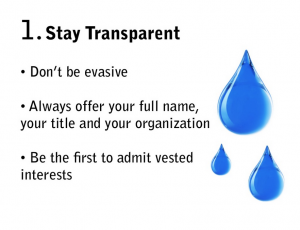I’m not as inspired about social media strategy as I was about social technographics, Groundswell and Empowered. This seems like more traditional marketing stuff, but perhaps that’s unavoidable.
Sure, we’re still listening and having conversations, but this all seems a bit more contrived. Personas was where things get a little shaky. Why create personas of the people you are trying to engage with when you have the real people right there?
In fact, could we not just crowd source our social media strategy? Put it on a Wiki, get out there and talk to people with tablets at the ready, email your customers and ask them to contribute, get your creators to make videos about how your company should manage social media.
Perhaps there are limits to devolving power, but shouldn’t we give it a try first?
Reviewing assets is definitely a smart thing to do, whether for social media or not. I’m particularly interested in including ‘volunteers’ in this review. Perhaps we can account for our customers, how engaged they are, our wider audience too – whether creators, spectators or somewhere in between. A valuable balance sheet for any company for sure.
Goals seem to be something that come from the organisations broader strategic plan, but how was that plan developed? Did we listen before we developed that plan? Perhaps this is a good time to revisit the strategic plan and make sure it is informed by the listening that we’ve done.
Benchmarking and gathering data is such a rich environment online. Just when all this strategic stuff can seem a little fluffy, you realise that every element of the strategy in the online world can be measured – clicks, mentions, followers, sales, customers, traffic, links, shares – it’s all there to be measured. Analytics can show us not just who is visiting and when but how they travel around our site and where they go afterwards.
Privacy is of course a concern, but for organisations paying attention, there’s a lot that can be discovered from good analysis, data and benchmarking.
Clarifying the message makes a lot of sense, but it’s also somewhat at odds with the principles of social media. The audience is diverse, our customers have individual attitudes, concerns and ways of interacting. If we become too focused on one message we risk losing the genuine interaction with people that social media is all about.
Choosing a channel is certainly a challenge, but if you do your research and know who your audience is and where they are, it should be a lot easier. The temptation is going to be to try and be everywhere, but as always, it may be better to do less things well than do many things badly.
Ahhh, the conversation, this is where it’s at. I particularly like this slide:
It seems to be the best advice you could offer to start with when entering the social media world. If you’re being transparent and honest, doing the wrong thing is more likely to ring alarm bells before you actually go ahead and make a mistake.
As always, we return to listening. My ears are open, how about yours?

